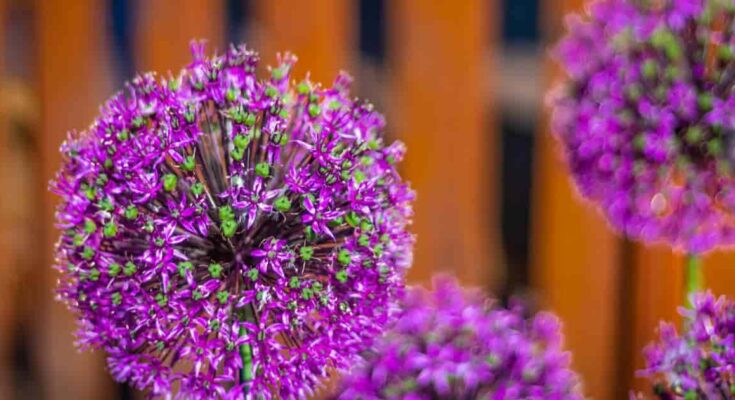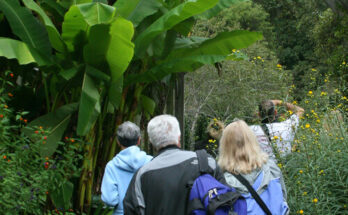When someone mentions alliums, the first association people tend to make is onion or garlic, but that’s just the tip of the iceberg for the Allium genus.
In reality, allium flowers are among the most sensational and show-stopping displays a gardener can plant. A perfect example of this is Allium ‘Globemaster’, a hybrid of Allium christophii and Allium macleanii.
One of many plants in the genus commonly referred to as an ornamental onion, ‘Globemaster’ was created by J. R. Bijl van Duyvenbode and officially registered in 1971.
As with several plants in the Amaryllidaceae family, this hardy perennial was awarded the Royal Horticultural Society’s Award of Garden Merit, one of the more prestigious awards.
Allium ‘Globemaster’ Care
Size And Growth
Allium ‘Globemaster’ is a hybrid on the medium side of the allium scale, reaching only 2 ½’ feet tall and 1 ½’ feet across at maturity.
The lower portion has greyish-green leaves, but other plants hide the foliage as with most allium leaves.
In act, the leaves will often begin to whither soon after ‘Globemaster’ blooms.
However, this foliage is considered fragrant and will give off a mild garlic smell when bruised.
Flowering And Fragrance
In late spring, the Allium ‘Globemaster’ plant’s tall stem bursts into an 8” to 10″ inch wide globe made from hundreds of star-shaped, deep lilac-pink flowers.
The flowers dry out rather than outright wilt, allowing the display to remain well into early summer.
It’s not uncommon for people to harvest long-lasting flower heads to use in flower arrangements due to their ability to hold onto their color.
Light And Temperature
For the most part, ‘Globemaster’ needs full sun to be at its best.
However, it isn’t well-suited for subtropical or arid climates and may scorch in intense sun.
In such locations, it’s best to give it some light shade at midday.
Regarding growing locations, ‘Globemaster is best-suited for USDA hardiness zones 5 to 6.
The plant must enjoy spring temperatures around 55° to 60° degrees Fahrenheit, as warmer temperatures will cause the plant to wilt slightly, resulting in weaker stems.
As long as the bulb has been planted 4″ to 5″ inches below ground (preferably given a little mulch in winter), it can handle winter temperatures in these zones.
Planting too shallow or in a container when multiple freezes and thaw cycles can make the bulbs rot, so winter insulation is essential.
Watering And Feeding
As with most plants, the soak and dry method works best for ‘Globemaster.’
Water when the soil feels dry 1″ to 2″ inches down to avoid the risk of rot or fungal infections.
Alliums are adapted to survive in places a lot of other plants can’t, including areas with poor soil quality.
As a result, ‘Globemaster’ doesn’t require fertilizer to thrive.
Soil And Transplanting
Speaking of adaptations, you can plant this allium in just about any soil type as long as it drains well.
Clay soils will need some coarse sand or perlite mixed in to improve drainage, although sandy and loamy soils won’t need to be amended.
An acidic to slightly acidic pH of 5.5 to 6.5 is important for the best blooms, but it can still grow in neutral soil (albeit a little smaller).
This perennial isn’t often grown in pots, but if you do, it’s a good idea to bring it inside for winter and keep it in a cooler place, such as your garage or basement.
Both indoors and outdoors, it’s a common practice to uproot the plant and divide the bulb once the foliage has died back, although you don’t need to change potting soil at this time.
Soil changes for potted plants should be once every 2 to 3 years just to eliminate any buildup of mineral salts or other toxic materials.
Grooming And Maintenance
You’ll be surprised to learn that ‘Globemaster’ is essentially maintenance-free.
The foliage is sparse and will only need to be pruned in the event of disease.
Meanwhile, deadheading the massive blooms won’t encourage further blooming, so it’s best to let them wilt on their own.
How To Propagate Allium ‘Globemaster’?
Unlike a large percentage of allium species, ‘Globemaster’ is a sterile hybrid.
This means that it’s not only unable to self-seed, but it’s completely incapable of producing seeds at all.
Instead, division is the only reliable method to propagate this flowering onion.
It’s best to divide the bulbs in late summer to early fall once the foliage has died back and plant them in the fall.
Ornamental Onion Pests Or Diseases
Allium ‘Globemaster’ is tolerant to deer and drought and resistant to the chemicals that black walnut trees release.
Due to the repellent properties of alliums, you likely won’t have any pest issues when growing ‘Globemaster.’
Furthermore, disease is rare, with downy mildew and white onion rot being the two most common problems.
While safe around birds, humans, horses, and livestock, please remember that all alliums are toxic to cats and dogs.
Allium ‘Globemaster’ Uses
When you want an outstanding cut flower, ‘Globemaster’ never fails to impress with its long-lived, gigantic blooms.
Its medium size and bare stem make it perfectly suited for being in the middle row of a border display or interspersed amongst ornamental grasses.
As with other alliums, ‘Globemaster’ is an excellent companion plant that will not only repel pests but also attract butterflies, bees, beneficial insects, and other pollinators.
Finally, while it’s uncommon, you can grow ‘Globemaster’ in pots or planters for a little extra visual spice in any sunny room.
More on Caring For Allium Bulbs
Source link
Originally posted 2022-09-26 17:41:14.





